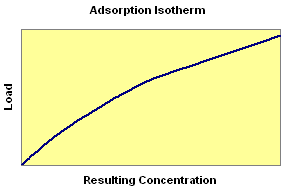SESOIL Soil Input Parameters
The soil input file contains information on physical properties of the soil. These properties are
used by the SESOIL hydrologic and pollutant cycle submodels. Values for these parameters are
typically obtained as part of the site investigation or can be estimated based on soil type.
1.1 Intrinsic Permeability
Permeability is a measure of the rate at which water can flow through the soil. SESOIL uses
intrinsic permeability in cm2. Permeability in cm/sec can be converted to intrinsic
permeability by multiplying by 1.0E-5 cm-sec.
Soil permeabilities are typically based on laboratory analysis. Depending on specific site
conditions it can be based on groundwater permeability measurements. At other location it may be
established based on soil type. Permeability in the soil input file is applied to the entire
soil column. Varying permeabilities with depth can be entered in the SESOIL application input file.
1.2 Organic Carbon Content
The organic carbon content is defined as the percent of organic carbon of the soil. This is one
of the most important site-specific parameters and care should be taken as to which analytical
method should be used.
The soil input file contains the percent organic carbon content of the uppermost soil layer.
Values for organic carbon content in the lower layers can be established in the SESOIL
application file.
1.3 Soil Bulk Density
Bulk density is the amount of mass per unit volume of dry soil in g/cm3. SESOIL
uses this soil input value for the entire column and there are no provisions for varying bulk
densities with depth.
1.4 Effective Porosity
Effective porosity is the fraction of interconnected pore space to the total volume of the soil.
This parameter is difficult to measure and is typically estimated based on soil type. Default
values can be found in the SEVIEW 6.2 documentation. Porosity in the soil input file is applied
to the entire soil column and there are no provisions for varying values with depth.
1.5 Soil Pore Disconnectedness Index
It seems that all vadose zone models have at least one unusual input parameter. The soil pore
disconnectedness index is perhaps the most unusual of all of the SESOIL input parameters. This
parameter deals with wetting and drying fronts in the soil column associated with precipitation
events. As such the soil pore disconnectedness index can have a strong influence on the movement
of soil moisture and thus the fate of contaminants.
2.2 Cation Exchange Capacity
The cation exchange capacity is a measure of the number of positively charged cations that can be
adsorbed to a given volume of soil. It is typically reported in milliequivalents per 100 grams of
soil. SESOIL uses the cation exchange capacity along with the chemical valence to simulate the
sorption of metals to soil.
Information entered in the soil input file is used to establish the cation exchange capacity of
the uppermost soil layer. Relative values for lower soil layers can be established in the SESOIL
application input file. The cation exchange capacity is only active in SESOIL if a non-zero value
is entered for the chemical valance in the chemical input file.
2.3 Freundlich Exponent
The Freundlich exponent deals with how soil sorption varies with increasing contaminant load.
At low concentrations sorption is linear. However, as contaminant load is increased sorption
decreases, eventually the soil becomes saturated (Figure 1). The Freundlich exponent is used to
define how chemical sorption will respond as load is increased.
Given that most residual contaminant concentrations are significantly below soil saturation
limits, sorption is assumed to be linear (i.e. the Freundlich exponent is 1.0). The Freundlich
exponent value in the SESOIL soil input file is applied to the upper most soil layer. Relative
values for the Freundlich exponent in lower layers are entered in the SESOIL application input file.
Figure 1

|
|
|


